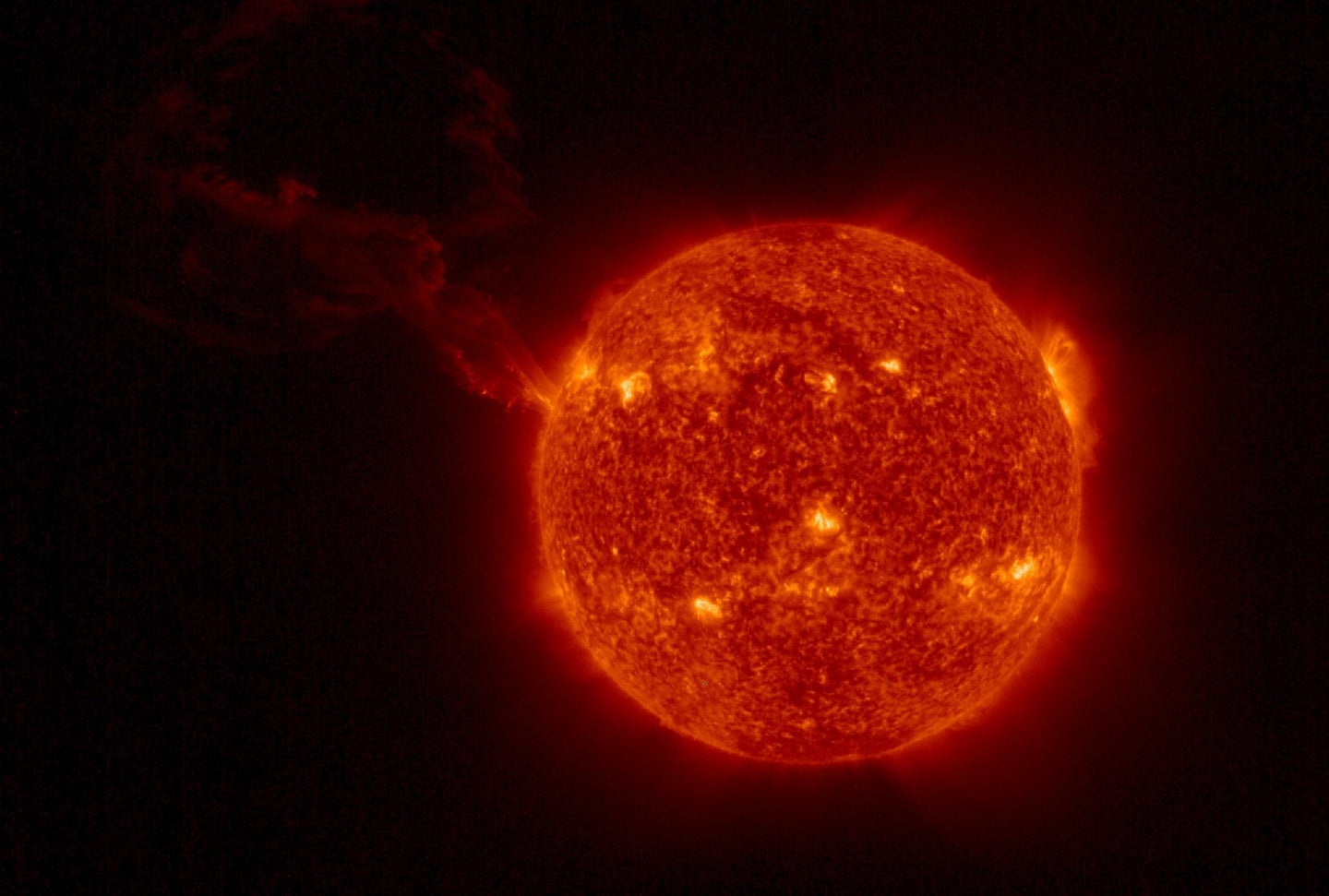First up, from Popular Science, July 31:
How worried should we be about solar flares and space weather?
NASA's heliophysics experts explain how space weather forecasting works, and why geomagnetic storms seem to be more disruptive than ever.

(probably not a slice of chorizo)
The sun roils with heat as thermonuclear reactions in its center produce high amounts of energy. Day to day, that energy is responsible for making Earth livable. But sometimes, solar radiation can burst forth, sending highly energetic particles hurtling at top speeds into space. If our planet is in the radiation’s path, it can wreak havoc on our lives.
“Our star is really an enormous thermonuclear furnace. At its center, the temperature is between 15 to 17 million degrees Celsius, and roughly 600 million tons of hydrogen get fused into 596 million tons of helium,” says Madhulika Guhathakurta, program scientist for NASA’s Heliophysics Division and lead program scientist for the “Living With a Star” initiative, which studies the ways in which Sun-Earth system affects human life and society. Every second, those four million missing tons are transformed into energy—what we see as sunshine. But “even a slight change in this very precariously controlled activity can have drastic consequences on Earth,” she explains.
Although such consequences are rare, satellites and technology that relies on electricity and wireless networks are particularly vulnerable. In 1989, a geomagnetic storm set off by a powerful solar flare triggered a major blackout across Canada that left six million people without electricity for nine hours. In 2000, a solar eruption caused some satellites to short-circuit and led to radio blackout. In 2003, a series of solar eruptions caused power outages and disrupted air travel and satellite systems. And in February 2022, a geomagnetic storm destroyed at least 40 Starlink satellites just as they were being deployed, costing SpaceX more than $50 million.
What exactly is space weather?Generally speaking, the term “solar storm” describes when an intense eruption of energy from the sun shoots into space and interacts with Earth. Charged particles constantly flow away from the sun into space in what is called the solar wind. But more significant eruptions can originate as solar flares, often from temporarily dark patches called sunspots, and intense explosions called coronal mass ejections. Any kind of variation in this activity can cause auroras.Solar flares are essentially flashes of light. They happen when strong solar magnetic fields protruding from the surface of the sun snap, releasing immense amounts of electromagnetic radiation at extremely high speeds. When that radiation slams into Earth, it injects energy into our planet’s ionosphere, the uppermost reaches of our atmosphere, explains Guhathakurta. The extreme ultraviolet radiation from the sun can polarize the particles in Earth’s ionosphere, she says, which can have cascading effects on any other charged particles in the vicinity–meaning anything that uses electricity is at risk....
....MUCH MORE
The folks at Government Attic get their kicks by rummaging around various government agencies via Freedom of Information Act requests.
From the FOIA fans at Government Attic, here's one they posted in 2017 (updated 2018):
Description of document: Unpublished internal FEMA reports and studies concerning risks from geomagnetic storms and solar flares, 2010-2012*
From page 25 of the PDF:
....How often do these events occur? According to the NOAA SWPC, there are on average 4 05 geomagnetic storms per solar cycle. The 1859 Carrington-Hodgson event is the strongest on record in the approximately 500 years of data that is available. Anecdotal observational records of low-latitude red aurora hint that the largest events may occur roughly every 500-600 years (Silverman, 2005). However, events strong enough to severely impact modern systems may occur as frequently as once in 100 years (Kappenman et al., 2007). Indeed two storms, 1859 and 1921 , were of sufficient strength that their repeat today could cause large-scale power grid collapse. Further, the March 13 , 1989 storm that collapsed the Hydro Quebec power grid in Canada came within seconds of collapsing the Northeast and northern Midwest U.S. power grid (Kappenman, 2005). Kappenman (2005) reports that "the size and intensity of this Westward Electrojet structure, had it developed 5- 7 h later, would have extended from east coast to west coast of the entire northern-latitude portions of the US power grid, and is likely to have produced much more significant consequential impacts ... ." It should be noted that the power grid, due to deregulation since 1989, is actually more vulnerable today (National Academy of Sciences, 2008)....
And from page 13:
...Table S: 0 Hour
Trigger:
• CME a rrives at Earth causing geomagnetic storm
o GEO satellites on daylight side exposed to solar plasma
o Some satellite communications and GPS signals
severely disrupted due to scintillation in ionosphere
o HF systems may work due to increased ionization at
ionosphere F Layer
o Significant power grid collapses may occur in North
America and elsewhere; could require 4 -1 0 years to
fully restore
o "Last mile" telecommunications lost where no backup
power available (e.g. cable, VoIP, data networks, etc.)....
....MUCH MORE (89 page PDF)
Oh.
The food riots would kick in somewhere between days 3 and 5 but the deaths from lack of electrically-pumped water in the cities would already have begun.
So no real worries about that 4-10 year timeline for complete repair of the grid.